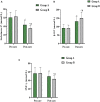Major Risk Factors Analysis of Pruritus Complicated by Type 2 Diabetes Mellitus and the Effect of Comprehensive Nursing Intervention
- PMID: 35242808
- PMCID: PMC8887712
- DOI: 10.3389/fsurg.2022.842884
Major Risk Factors Analysis of Pruritus Complicated by Type 2 Diabetes Mellitus and the Effect of Comprehensive Nursing Intervention
Abstract
Objective: To observe the main risk factors for pruritic skin evidence complicating type 2 diabetes mellitus (T2DM) and the effectiveness of interventions with comprehensive care measures.
Methods: Two hundred and twenty four patients with T2DM admitted to our hospital from June 2020 to November 2021 were selected and divided into Diabetic pruritus group (DP group, n = 71) and T2DM group (n = 153) according to the patients' complications of pruritus. General information such as gender, age, body mass index (BMI), duration of illness, family history, treatment modalities, other comorbidities, underlying illnesses were collected from all patients. Fasting plasma glucose (FPG), renal function [Serum creatinine (Scr), urea nitrogen (BUN), uric acid (BUA)], lipid levels [total cholesterol (TC), triacylglycerol (TG), high-density lipoprotein cholesterol (HDL-C), low-density lipoprotein cholesterol (LDL-C)] were measured in all patients on day 2 after admission. Risk factors for pruritus complicating T2DM were identified by single multifactorial analysis. Meanwhile, patients in the DP group were divided into group A (n = 35) and group B (n = 36) using the random number table method. Group A adopted the conventional care mode and group B patients adopted the comprehensive care interventions to compare the care effects [visual analog score (VAS) before and after care, treatment efficiency, care satisfaction rate] of patients in groups A and B; the levels of pruritus mediator indicators [substance P,β-endorphin (β-EP) and γ-interferon (INF-γ)] before and after care.
Results: Risk factors for pruritus in T2DM were age, duration of DM, combined Diabetic peripheral neuropathy (DPN), combined diabetic retinopathy (DR), combined diabetic kidney disease (DKD) and serum FPG levels (P <0.05). Satisfaction rate of nursing care, treatment efficiency, post-care improvement in VAS scores, serum substance P, β-EP and INF-γ levels and other mediators of pruritus were better in Group B with integrated nursing intervention than in group A with conventional care only (P < 0.05).
Conclusion: Pruritus in T2DM is associated with age, duration of DM, combined DPN, combined DR, combined DKD and FPG levels. Comprehensive care according to the above risk factors can effectively relieve patients' clinical symptoms and signs, improve the level of pruritus mediators and patient-care relationship.
Keywords: comprehensive care; pruritic medium; pruritus; risk factors; type 2 diabetes mellitus.
Copyright © 2022 Yang, Chen, Li and Xu.
Conflict of interest statement
The authors declare that the research was conducted in the absence of any commercial or financial relationships that could be construed as a potential conflict of interest.
Figures


References
LinkOut - more resources
Full Text Sources
Miscellaneous

